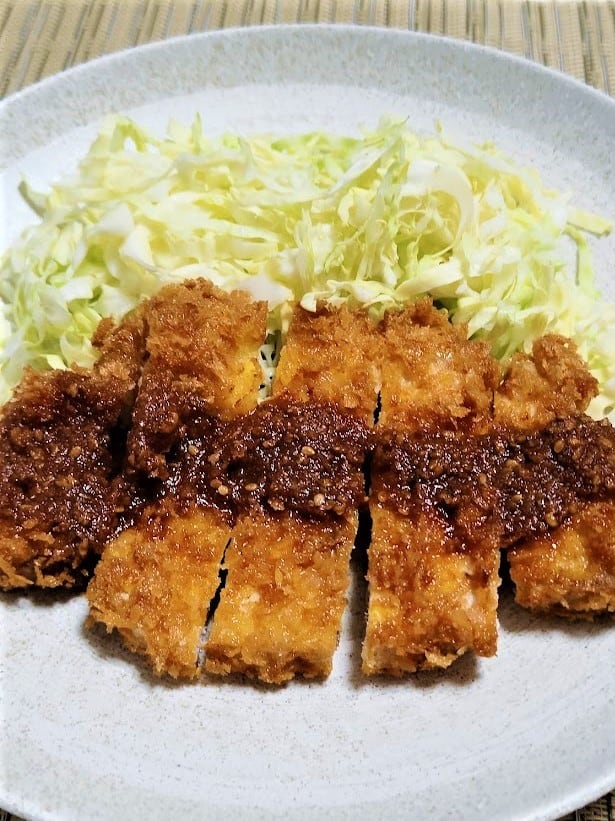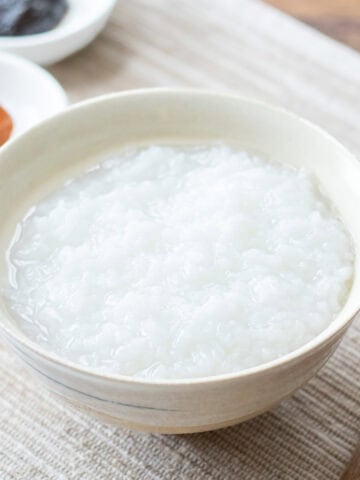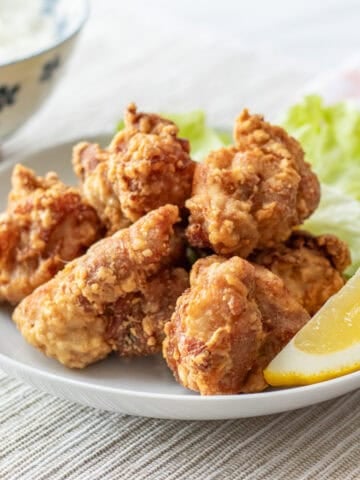Tonkatsu is one of the most popular deep-fried dishes in Japan. Each bite fills your mouth with the savory flavor of crispy breading and juicy pork, making it a delightful choice for a special meal.

Jump to:
What is Tonkatsu?
Tonkatsu is a dish made by coating thick slices of pork with flour, beaten eggs, and panko breadcrumbs, and then deep-frying them. "Ton" means pork, and "katsu" refers to cutlets. Since "katsu" is pronounced the same as the Japanese word '勝つ,' meaning to win, it is often eaten before exams or competitions as a symbol of good luck and a wish for success in Japan.
By coating the pork with breading, the outside becomes crispy, and the inside remains juicy. It is a popular dish beloved by people of all ages. This dish is most commonly enjoyed with a sauce called "Tonkatsu Sauce," but you can also savor it with salt and a squeeze of lemon juice.
Differences from traditional cutlets
Tonkatsu is often translated as 'Japanese pork cutlet,' but it is actually different from traditional cutlets in both flavor and texture. Although both are made by frying, cutlets are typically coated with breadcrumbs and pan-fried, while tonkatsu is coated with panko breadcrumbs and deep-fried. This results in a crispy, savory finish.
Additionally, thicker cuts of pork are often used for tonkatsu due to its cooking method. As a result, it has a characteristic juiciness and heartiness.
Tips on how to make more delicious
Tonkatsu is a very popular dish in Japan, so there are many tips for making it even more delicious, including the following. Even if you have made this dish before, try incorporating these tips to elevate your tonkatsu to the next level.
- Make several slits along the border between the lean and fatty parts of the pork before cooking. This helps prevent the pork from curling up during cooking. Additionally, after doing this, pound the pork. This helps ensure even thickness and uniform cooking.
- Coat the pork in the following order: flour, beaten eggs, and panko breadcrumbs. First, apply the flour to absorb excess moisture from the pork and help the beaten eggs stick better. Then, dip the pork in the beaten eggs to ensure that the breadcrumbs adhere more effectively.
- After coating the pork, let it sit for about 10 minutes to allow the breading to set. This process helps the breading adhere better to the pork, making it less likely to separate when you cut the tonkatsu.
- When deep-frying the pork, avoid turning it over more than necessary. Flipping the pork frequently can cause the oil temperature to drop and prevent the pork from frying properly.
- After deep-frying the pork, place it upright to drain excess oil. Standing it upright helps remove more oil.
The recipe includes all these tips. Don’t overthink it; just follow the instructions as they are, and you will have a delicious tonkatsu.
Exploring tonkatsu sauce
The sauce used for this dish is known as tonkatsu sauce, which gives it a rich, slightly sweet, and savory flavor. In Japan, commercially available varieties are commonly used, but you can also make it from scratch. Since it is easy and quick to prepare, if you can’t find it locally, you might want to try making it yourself.
For information on how to make tonkatsu sauce, please refer to the linked page.
What to serve with it
Tonkatsu is typically served with shredded green cabbage. The cabbage adds color and brightness to the dish while also serving as a palate cleanser.
In Japan, tonkatsu specialty restaurants often serve it with shredded cabbage, white rice, miso soup, and Japanese pickles. This combination is also a staple in many Japanese households, so I encourage you to give it a try.

📋Step-by-step recipe
Ingredients
- 2 boneless pork loin or tenderloin chops (⅗ inch/1.5 cm thick, 5 oz/140 g each)
- - pinch of salt (for the pork)
- - pinch of ground black pepper (for the pork)
- 3.5 oz green cabbage (for a side)
- 1.2 inches (3 cm) of neutral oil in the pot (for deep-frying)
Breading:
- 3 Tbsp all-purpose flour (plain flour)
- 1 large egg (about 2.1 oz/60 g, including shell)
- ⅔ cup panko breadcrumbs
Condiment:
- tonkatsu sauce (For information on how to make it, please refer to the linked article.)
Instructions
🕒 Total: 35 mins
Step 1
Cut cabbage into thin strips in advance to serve as a side.

Step 2
Make several slits along the border between the lean and fatty parts of the pork with the tip of a knife.

Step 3
Pound the pork with a meat tenderizer or the back of a knife to even out its thickness. Sprinkle salt and pepper on both sides.

Step 4
Crack egg into a bowl and beat it. Prepare three containers and place flour, the beaten egg, and panko breadcrumbs in each one separately.

Step 5
Coat both sides of the pork in this order: flour, beaten egg, and panko breadcrumbs. When applying the flour, gently shake off any excess with your hands. After coating the pork, let it sit for about 10 minutes to allow the breading to set.

Step 6
Heat oil in a pot to 340℉ (170℃). If you don't have a thermometer, drop a few panko breadcrumbs into the oil to test the temperature. When the breadcrumbs float to the surface at a moderate pace (not too quickly and not too slowly), it indicates that the oil is ready.

Step 7
Carefully place each piece of pork into the oil one at a time and deep-fry for about 1-2 minutes. Then, flip each piece over when the breading becomes slightly browned. Continue cooking until they are browned all over and the bubbles floating on the oil surface become smaller, which takes about 3-4 minutes. The total deep-frying time should be around 4-6 minutes (depending on the thickness of the pork).

Step 8
Remove the pork from the pot and place it upright on a wire rack or paper towels to drain excess oil. Let it rest for 3-5 minutes to lock in the juices.

Step 9
Cut the pork into ⅘-inch (2 cm) slices.

Step 10
Serve the pork slices on plates with the shredded cabbage on the side. Pour tonkatsu sauce over the pork to taste.
To store
You can store it in the refrigerator for up to 2 days.
How to dispose of used cooking oil
After enjoying tonkatsu, it is essential to properly dispose of the oil used for deep-frying. Pouring large amounts of oil directly down the drain can clog pipes.
In Japan, the most commonly recommended method is to use an oil-solidifying powder. This powder solidifies the oil, making it easy to dispose of.

If this is not available locally, you can also use materials like newspaper to absorb the oil or pour it into an empty container after it has completely cooled.
When disposing of used oil, be sure to follow your local waste disposal regulations.
If you try this recipe, I’d love to hear what you think. Please consider leaving a review and star rating in the comments below. If you enjoyed it, I’d really appreciate it if you shared it with your friends.
Recipe card

Tonkatsu (Crispy Japanese Pork Cutlet)
Ingredients
- 2 boneless pork loin or tenderloin chops (⅗ inch/1.5 cm thick, 5 oz/140 g each)
- - pinch of salt (for the pork)
- - pinch of ground black pepper (for the pork)
- 3.5 oz green cabbage (for a side)
- 1.2 inches (3 cm) of neutral oil in the pot (for deep-frying)
Breading:
- 3 Tbsp all-purpose flour (plain flour)
- 1 large egg (about 2.1 oz/60 g, including shell)
- ⅔ cup panko breadcrumbs
Condiment:
- tonkatsu sauce (For information on how to make it, please refer to the linked article.)
Instructions
- Cut cabbage into thin strips in advance to serve as a side.
- Make several slits along the border between the lean and fatty parts of the pork with the tip of a knife.
- Pound the pork with a meat tenderizer or the back of a knife to even out its thickness. Sprinkle salt and pepper on both sides.
- Crack egg into a bowl and beat it. Prepare three containers and place flour, the beaten egg, and panko breadcrumbs in each one separately.
- Coat both sides of the pork in this order: flour, beaten egg, and panko breadcrumbs. When applying the flour, gently shake off any excess with your hands. After coating the pork, let it sit for about 10 minutes to allow the breading to set.
- Heat oil in a pot to 340℉ (170℃). If you don't have a thermometer, drop a few panko breadcrumbs into the oil to test the temperature. When the breadcrumbs float to the surface at a moderate pace (not too quickly and not too slowly), it indicates that the oil is ready.
- Carefully place each piece of pork into the oil one at a time and deep-fry for about 1-2 minutes. Then, flip each piece over when the breading becomes slightly browned. Continue cooking until they are browned all over and the bubbles floating on the oil surface become smaller, which takes about 3-4 minutes. The total deep-frying time should be around 4-6 minutes (depending on the thickness of the pork).
- Remove the pork from the pot and place it upright on a wire rack or paper towels to drain excess oil. Let it rest for 3-5 minutes to lock in the juices.
- Cut the pork into ⅘-inch (2 cm) slices.
- Serve the pork slices on plates with the shredded cabbage on the side. Pour tonkatsu sauce over the pork to taste.
Notes
- You can store it in the refrigerator for up to 2 days.





Leave a Rating and a Comment